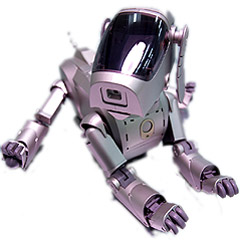|
We
often ascribe human attributes to animals or human form
or attributes to objects that are not human. This is called
anthropomorphism. We interact with objects, tools, machines
and pets and may form 'attachments' to them, give them names,
or direct emotions towards them.
Activity
One of the most obvious demonstrations of this is Gary Larson's
animal comics. You know the ones where the animals behave
with human characteristics. Although there is no images
on the web of his comics we found a thesis dealing with
his strategy. Visit this
site for an insight into Gary Larson's anthropomophisation
of animals. Or visit android
world to see anthropomorphic design in robots.
A
robotic companion
The Aibo was designed as a product that could be a robotic
pet. In order to achieve this, Sony needed a product that
could simulate the behaviour of a pet. The Aibo product
has been deliberately modelled upon a dog because this is
an animal that humans already anthropomorphise. The dog
was the first animal to be domesticated; 20,000-year-old
graves have revealed the remains of humans buried with their
faithful companion, the dog.
In
Tear down the techniques used to create anthropomorphic
qualities, such as response to touch or following a ball,
are explained. Apart from these design decisions there is
the aesthetic appeal of the Aibo's exterior shell. Hajime
Sorayama designed the Aibo's physical appearance. Visit
a site that explores other designs by this artist.
|
A
special case: Pixel
The Aibo handlers at the Powerhouse Museum decided
to name and gender their Aibo. They decided that Pixel
was a good name for a female Aibo — a pixel is
diminutive (small) and digital, as is an Aibo.
Unlike
real domestic pets, where their gender is apparent,
an Aibo's owners determine its gender. Pixel is female
and her handlers think of her as being female.
|
 Photo:
Penelope Clay
Photo:
Penelope Clay |
Feedback
Unlike a manual for a VCR or a fax machine the Aibo manual
anthropomorphises the Aibo's functionality and use. Aibos
have been designed to display feedback to their users to
let them know what 'state' they are in. The hardware used
to display these states include:
- red
and green lights
- sound
files
- robotic
movement.
This
movement is interpreted as the 'attitude' of the Aibo, for
example, the tail section wagging, making sounds, cocking
its head section, moving robotic limbs playfully or interactively.
All these features help create a sense of the Aibo being
'alive' and not just a computerised robotic product.
Emotional feedback
Through the use of hardware and software Aibos exhibit a
range of 'states' including:
| Joy:
|
When
an Aibo is immersed in a favourite activity, receives
approval, finds a favourite colour or plays with a ball. |
| Sadness: |
When
an Aibo cannot find anyone to play with, or when it
is low on batteries and there is no one to help. |
| Anger: |
When
an Aibo is ignored or neglected, left on the station
when ready to resume activity, or when it is scolded. |
| Surprise: |
When
someone suddenly grabs its attention, or when an Aibo
hears loud sounds. |
| Fear: |
When
an Aibo finds a large gap in the floor, or when it is
unable to get up from a fall. |
| Discontent: |
When
someone shows a colour to an Aibo that it dislikes,
or when its anger towards someone escalates. (Sony,
1999: 54) |
Activity
Compare and contrast the behaviour of an Aibo and that of
a real pet.
Identify:
| a) |
the
behaviours an Aibo is not capable of |
| b) |
the
feelings you may not experience with an Aibo that you
would with a pet. |
Think
about:
| a) |
why
was it necessary to reduce the range of abilities of
the Aibo compared to a real dog? |
| b) |
why
was it impossible, or at the very least very difficult,
to manufacture a machine that could do more things? |
| c)
|
why
these limitations present a 'space' between the real
and the virtual. Which other animal or human qualities
or functions do you think could not be replicated by
'intelligent' machines? Why? |
|